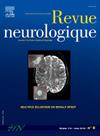Model-based cueing-as-needed for walking in Parkinson's disease: A randomized cross-over study
IF 2.8
4区 医学
Q2 CLINICAL NEUROLOGY
引用次数: 0
Abstract
Background
Correcting of the lack of regularity in steps is a key component of gait rehabilitation in Parkinson's disease. We proposed to introduce adaptive spatial auditory cueing (ASAC) based on verbal instruction “lengthen the step” automatically delivered when the stride length decreased below a predetermined threshold.
Objectives
The present study compared the effect of usual rhythmic auditory cueing versus ASAC used during a walking training in Parkinson's disease.
Methods
Fifteen patients with Parkinson's disease performed both interventions in randomized order, one week apart: a 20-minute walking training with rhythmic auditory cueing, in form of a metronome adjusted on 110% of the patient's own cadence, or ASAC delivered when the stride length is less than 110% of the patient's own stride length. Assessment criteria were walking distance covered during the intervention, speed, step length, cadence, coefficients of variation of step length and step duration, and indexes of spatial and temporal asymmetry during a walking test before and just after the intervention.
Results
The walking distance is higher with ASAC compared with rhythmic auditory cueing (rhythmic auditory cueing, 905 (203) m, mean (standard deviation); ASAC, 1043 (212) m; P = 0.002). Between-intervention comparison showed some similar effects on walking after the intervention including free speed and step length increases (P < 0.05).
Conclusion
The distance covered during 20-minute walking with ASAC increases by 15% compared to the use of classical rhythmic auditory cueing, while the immediate therapeutic effects show similar spatial-temporal benefits on short-distance walking. Auditory biofeedback cueing promoting the increase in step length might improve gait relearning in Parkinson's disease.
基于模型的帕金森病患者行走提示:随机交叉研究
背景:纠正步伐缺乏规律性是帕金森病步态康复的关键组成部分。我们建议引入自适应空间听觉提示(ASAC),当步长下降到预定阈值以下时,自动发出 "延长步长 "的口头指令:本研究比较了帕金森病患者在步行训练中使用普通节奏性听觉提示与 ASAC 的效果:15名帕金森病患者按照随机顺序进行了两种干预,时间间隔为一周:20分钟的步行训练,采用节拍器的形式进行有节奏的听觉提示,节拍器调整为患者自身步速的110%,或在步长小于患者自身步长的110%时进行ASAC。评估标准包括干预期间的步行距离、速度、步长、步频、步长和步长变异系数,以及干预前后步行测试中的空间和时间不对称指数:结果:与有节奏的听觉提示相比,有节奏的听觉提示的步行距离更长(有节奏的听觉提示,905(203)米,平均值(标准差);有节奏的听觉提示,1043(212)米;P=0.002)。干预之间的比较显示,干预后的步行效果相似,包括自由速度和步长的增加(PC 结论:在 20 分钟的步行过程中,听觉提示的步行距离增加了 10%:与使用经典节奏性听觉提示相比,使用 ASAC 进行 20 分钟步行的距离增加了 15%,而即时治疗效果则显示出对短距离步行具有类似的时空益处。促进步长增加的听觉生物反馈提示可改善帕金森病患者的步态再学习能力。
本文章由计算机程序翻译,如有差异,请以英文原文为准。
求助全文
约1分钟内获得全文
求助全文
来源期刊

Revue neurologique
医学-临床神经学
CiteScore
4.80
自引率
0.00%
发文量
598
审稿时长
55 days
期刊介绍:
The first issue of the Revue Neurologique, featuring an original article by Jean-Martin Charcot, was published on February 28th, 1893. Six years later, the French Society of Neurology (SFN) adopted this journal as its official publication in the year of its foundation, 1899.
The Revue Neurologique was published throughout the 20th century without interruption and is indexed in all international databases (including Current Contents, Pubmed, Scopus). Ten annual issues provide original peer-reviewed clinical and research articles, and review articles giving up-to-date insights in all areas of neurology. The Revue Neurologique also publishes guidelines and recommendations.
The Revue Neurologique publishes original articles, brief reports, general reviews, editorials, and letters to the editor as well as correspondence concerning articles previously published in the journal in the correspondence column.
 求助内容:
求助内容: 应助结果提醒方式:
应助结果提醒方式:


